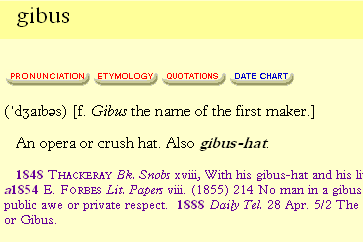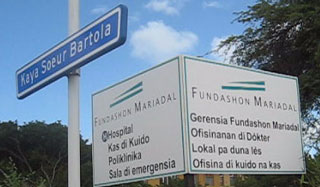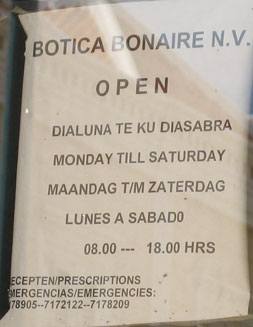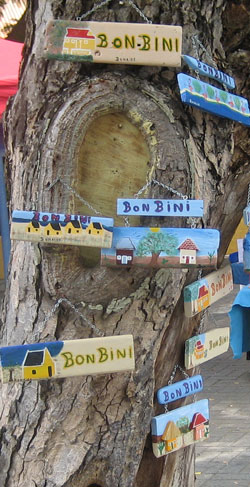DEPARTMENT OF SPEECH, HEARING & PHONETIC SCIENCES UCL Division of Psychology & Language Sciences |
 |
John Wells’s phonetic blog archive 1-14 February 2008To see the IPA phonetic symbols in the text, please ensure that you have installed a Unicode font that includes them all, for example Lucida Sans Unicode or Charis SIL (click name for free download). Browsers: I recommend Firefox (free) or, if you prefer, Opera (also free). email: |
|
Thursday 14 February 2008 | Stating the bleeding obviousThere’s what is described as a “terrible Essex joke” in yesterday’s Guardian. Nurse, in casualty, to injured patient: Where are you bleeding from? (Explanatory note for Americans and other non-Brits: the patient wrongly interprets bleeding as an expletive. See the Concise Oxford Dictionary: bleeding adj. & adv. Brit. coarse slang expressing annoyance or antipathy. Casualty = the E.R. The inhabitants of Romford, a suburb in Essex out beyond London’s East End, are stereotypically white working-class Londoners and thus supposedly likely to swear a lot.) The trouble is that as a spoken joke this doesn’t actually work. The reason is that the two readings of the ambiguous question differ in tonicity (= nucleus placement). The nurse’s question asks what part of his body is the source of the blood: (1) 'Where are you 'bleeding from? But the patient’s answer is an answer to a different question, one about the patient’s origins: (2) 'Where are you bleeding 'from? Version (1) is parallel to other examples such as 'What are you 'looking at? Version (2) is just an expansion of the expletive-free 'Where are you 'from? The way I explain this point in English Intonation (section 3.17) is that the nucleus goes on the last lexical item (= the last content word) if there is one. That accounts for (1). If there is no lexical material — no content words — it goes on the preposition. That accounts for (2). And what the tonicity difference seems to demonstrate is that bleeding and its more forceful variants do not count as content words. So a nuclear accent on bleeding, as in (1), is a signal that the word is to be interpreted literally, lexically. PS Nigel Greenwood correctly points out that the joke works if the patient begins the exchange with the words Look! Me shirt’s covered in blood! I'm bleeding! Then the nurse’s question would take the form (2). |
|
Wednesday 13 February 2008 | Phonetic incunabulaMy picture today shows an excerpt from Daniel Jones’s first published work, 100 Poésies Enfantines (Leipzig: Teubner, 1907). Like the Brel clip (5 Feb.) it demonstrates an admirable multilingualism: a book in French by an English author from a German publisher.
As its title indicates, the book consists of nothing but a hundred French nursery rhymes, all in phonetic transcription. (I really wonder how Jones persuaded Teubner to take it on. Sales can hardly have been extensive, even twenty years later when Jones had become better known. Teubner made a wise investment, though, because in due course it was they who published Jones’s Outline of English Phonetics, 1st edn. 1918 through to 8th edn. 1956.) The orthographic text, given in smaller type at the back of the book, reads Une poule sur un mur, In the transcription the first thing that strikes us is the use of an acute accent as the stress mark. This symbol was changed by the IPA in 1927. See the scan below from m.f. (Le Maître Phonétique) 18: 14, Apr-Jun 1927, a report of desizjɔ̃ dy kɔ̃sɛːj [Council decisions]. Like everything else in the journal, this was in phonetic transcription. At the time the official language of the IPA was French.
[(2) They decide that the stress mark shall henceforth be represented by a vertical line ˈ in preference to the oblique line used until now; and that ˌ shall be used to represent secondary stress. (In favour 11, against 2, did not vote 3.)] The second striking thing is the symbol for the open-mid front rounded vowel, ʚ instead of œ. (In the nursery rhyme text it is nasalized, ʚ̃.) Similarly, the book has ɵ for the French vowel usually written ø. These were not official IPA symbols at the time. I have not checked back thoroughly in old issues of the m.f., but I have found that ʚ is included in the 1926 version of the IPA Chart, for a half-open rounded central vowel. By 1928 it disappears from the Chart, not to reappear until the 1989 revision. In the m.f. the French vowels are everywhere written œ and œ̃, never ʚ and ʚ̃. Perhaps the use of ʚ and ɵ for French was an experimental innovation by Jones, later dropped. There’s more about the nursery rhyme book in Collins and Mees’ biography of DJ, The Real Professor Higgins (Mouton de Gruyter, 1999), p. 33-34 — which by the way I note that amazon.com are offering at a real bargain price. PS Both Christopher Bergmann and Nigel Greenwood write to point out that there is a mistake in transcription in the last line of the report of the Council’s decision. It should read vɔtɑ̃ (votants), not vɔ̃tɑ̃. |
|
Tuesday 12 February 2008 | Low and longPhil Jaggar wrote to me as follows. Using Gentium on a Mac, and needing a combination macron/grave on all five (Hausa) long vowels, I can only find the combination on ‘e’ and ‘o’. Am I missing something here (quite possible as the years advance)?! No, Phil, you’re not missing anything. It’s Unicode that is missing something, namely precomposed characters for a, i, u with both a macron (ˉ) and a grave accent (`). Unicode 5.0 does indeed include provision for e and o with the desired combination of diacritics (see alongside, if your browser and fonts are up to it). But not for the other vowel letters. This must mean that no one has yet made a case for these combinations to the Unicode Consortium committee that recommends the inclusion of new symbols. To succeed in such a case I think the applicant would have not only to demonstrate substantial existing printed usage of the symbol but also to show that a combination of base letter plus diacritic would not be workable. The advice given on the Unicode faq page is that we should use just such a combination. We should combine a-macron (ā, U+0101), i-macron (ī, U+012B) and u-macron (ū, U+016B) with the combining grave diacritic ( ̀, U+0300). In the fonts I experimented with to do this, the results are not very good. But that is a problem with the fonts and/or the rendering software rather than with Unicode per se. See alongside for what your browser and font manage. Or we could fall back on IPA and write length with an IPA length mark (ː) following the grave-bearing vowel (thus àː, ìː, ùː). Historically, it was because of the difficulties of multiple diacritics and multistorey symbols that the IPA adopted that mark for length rather than the macron. |
ḕ ṑ ā̀ ī̀ ū̀ |
Monday 11 February 2008 | Not anybodyI saw a woman reading a novel entitled Sans rien ni personne. The word-for-word translation of this French title is Without nothing nor nobody, but in standard English we avoid double negatives (and double virtual negatives), so would have to say Without anything or anybody. I was considering how I would say this translated title aloud. The obvious accentuation pattern would be Without 'anything | or 'anybody But this involves accents on a repeated item, if we count the morpheme any- as an ‘item’. So there is a certain pressure to say instead Without 'anything | or any'body or even Without any'thing | or any'body It is fairly rare to overturn lexical word stress in order to avoid repetition or to signal contrastiveness, but it does happen. We could also try and translate the title more idiomatically and informally. I was thinking of Not a bean, not a soul, but for a British readership it might perhaps most naturally come out as Haven’t got a sausage, can’t see a soul. That wording might lack a certain romantic je ne sais quoi. But at least it avoids the problem of clashing accents. 'Haven’t got a 'sausage, | 'can’t see a 'soul. |
Friday 8 February 2008 | Taiwan EnglishMany thanks to Karen Chung for allowing me to reproduce this transcription of ‘Taiwan English’ — English as it might typically be pronounced by someone from Taiwan. Bear in mind that schools in Taiwan are all supposed to teach American English, not British. However I think most of this would apply to English in much of mainland China, too, where British English is the norm. The instruction Karen gives her students is “First, read the text out loud to decipher it, then write it out in regular English orthography.” Readers might like to try their hand. |
|
| ||
|
Notice how
You would think the loss of final consonants would be particularly devastating for intelligibility. However, this seems to be characteristic of some African-American English, too, and the results are apparently not too catastrophic. | ||
Thursday 7 February 2008 | Saving streaming videoYesterday’s blog enabled you to see and hear the demonstration of Nama clicks. But how can you save this and similar clips locally, on your own computer? If you could do that, you would be able to play them again when you are not on-line. My colleague Mark Huckvale has written a useful audio advice page. But this is a question he doesn’t answer there. So I asked him what I could do. He replied telling me how he did it himself. First I went to keepvid.com and typed in the youtube URL, which allowed me to download a .FLV (Flash Video) file. I followed these instructions, and they work! I can now use the click clip in lectures. Here are two nice examples I have recently come across which are ambiguous in writing but normally distinguished by tonality (or chunking) in speech. People who do this often get bored. In speech we could have either People who do this | often get bored, or People who do this often | get bored. And either Subscribing now | means... or Subscribing | now means .... The adverb of time can go either way. So there is no ambiguity in speech. |
|
Wednesday 6 February 2008 | Clicks demonstratedOn YouTube I found a very clear demonstration of clicks (cf. blog, 7 April 2006). They are among the speech sounds of the Namibian language that the speakers in the video clip call KhoeKhoegowab. According to Ethnologue, KhoeKhoegowab is an alternative name for Nama (Nàmá; formerly known as Hottentot). It is a national language in Namibia, with a quarter of a million speakers. Here’s the video clip.
This brings out the differences between the four click types very clearly.
In the IPA column, “was” means the IPA symbol in use before the 1989 IPA Kiel Convention. “Zulu-Xhosa” means in the orthography of Zulu, Xhosa, and other Nguni languages. For #, printed books often write ≠ (the doesn’t-equal sign). From the example sentence in the clip — /khim !nu #hab //ga — it seems that the language has not only plain clicks (voiceless, unaspirated, probably with an accompanying glottal stop) but also aspirated (/kh), nasalized (!n) and voiced (//g) — though the last-named doesn’t always sound very voiced here. The click in the third word, #hab, sounds to me breathy-voiced and nasal, as if it were Zulu ng# (i.e. the pulmonic-air part sounds like that of the Zulu breathy-voiced nasalized clicks ngc, ngq, ngx — Zulu doesn’t have #); however Wikipedia classifies it as “voiceless nasal with delayed aspiration”. | ǀ ǃ ǂ ǁ |
Tuesday 5 February 2008 | GibusIn his excellent World Wide Words website Michael Quinion recently discussed the word gibus. As he aptly comments, It’s one of those words that have almost entirely gone out of the language because the things they refer to are now rarely used, though gibus is still to be found in several British dictionaries. It means a kind of collapsible top-hat. None of the current pronouncing dictionaries include the word, and Quinion does not discuss the question of its pronunciation. However it was to be found in the Daniel Jones EPD, where it survived until Peter Roach took over as editor (1997). Here’s the 1991 edition:
So it was usually ˈdʒaɪbəs. Given that it was named after a Frenchman, Antoine Gibus, who invented it in the early nineteenth century, it is slightly surprising that in English it was apparently not pronounced in the French way as, say, ʒiːbəs, or indeed ˈʒiːbjuːs. This is from the Collins-Robert French Dictionary, 2006:
The OED agrees with Jones.
The gibus is not mentioned in the extensive list of hats and headgear in Wikipedia. PS: Nigel Greenwood sends this link to a video clip of Jacques Brel singing Place de Broukère on voyait l'omnibus Why this website is Russian, with the MC’s introduction in Dutch to a song in French, is a mystery, at least to me. Long live multilingualism. |
|
Monday 4 February 2008 | Audio pronunciations on lineWhere on the web can you find a free spoken pronunciation dictionary of English? That is, a website where you can click on any word to hear an audio version, a sound clip of its pronunciation? I used to tell people that the only such resource that I knew of was the Merriam-Webster Online Dictionary, (which of course is for American English). On that website there is also a written phonetic transcription of each headword, though M-W use their own strange transcription system instead of IPA. But now there are others. Pearson Education have made the Longman Dictionary of Contemporary English available on-line. The website includes “selected headwords pronounced in British and American English”, although for the full list you have to buy the book with its CD-ROM. (The definition and IPA transcription of every headword is available free, but rather few of them have free audio clips.) LDOCE uses IPA. CUP have audio samples available too, but apart from a few free samples you have to pay for them, or buy the book and CD-ROM. |
|
|
Tim Bowyer contacted me to draw my attention (and yours) to a facility he has created called howjsay.com, “an English Pronouncing Dictionary with Instant Sound”. I had a look at it and commented that it must have involved a lot of work, to which he replied ...Yes, it's a lot of work - about two minutes per word altogether. I created it and I record all the sounds myself - my background is principally in TEFL. The aim is to create a corpus representing anglophone pronunciations that are commonly understood and used globally. So for example the American 'tomeitou' is prefixed "also American", meaning the British pronunciation is more current outside the US. So it’s a one-man work in progress. But it’s free, and it seems well put together. See what you think of it. Tim also runs fonetiks.org, which offers audio clips of sets of keywords in various regional varieties of English and foreign languages, also free; and shiporsheep.com, with audio clips of English minimal pairs. PS Andrej Bjelaković tells me of another resource I had missed: www.thefreedictionary.com. It has spoken versions in AmE. He also mentions dictionary.com, who charge for the premium access needed for audio clips. And while we’re on the topic of sound clips, it occurs to me that I’ve never given you a sample of my own voice. So here you are. |
Friday 1 February 2008 | Papiamento and PapiamentuIn the ABC islands of the Netherlands Antilles (Aruba, Bonaire, and Curaçao) the everyday spoken language is Papiamento or Papiamentu, a Spanish/Portuguese-based creole. (The spelling of the name of the language depends on which island is concerned.) But education from primary school upwards is in Dutch, and Dutch is the language of administration and government. Schoolchildren also learn Spanish and English, and by school-leaving age are (reportedly) proficient in all four languages.
The plural ending in Papiamentu is -nan, pronounced naŋ (with the final nasal being velar, as in Venezuelan Spanish). In the hospital sign you can see both the plural ofisinanan ‘offices’ and the singular ofisina ‘office’. In the bank ATM screen (blog, 21 Jan.) there was the word bankomatikonan, containing the same plural ending. Nan is also the 3rd pl pronoun, ‘they, them’. What its etymology is, I don’t know, though it looks African. The word for ‘street’ is kaya, from Spanish calle ˈkaʎe or ˈkaje. |
|
Archived from previous months:
To search my web pages, use this Google search.


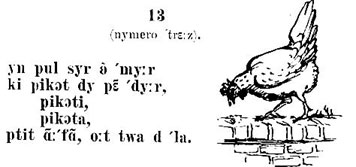





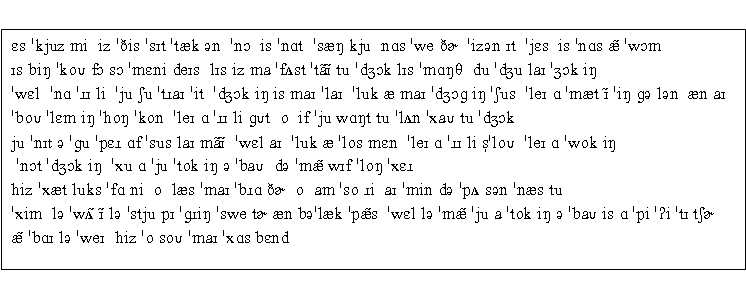

 .
.

